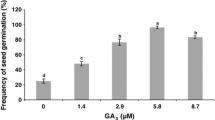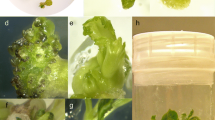Summary
Plant regeneration was achieved from both a spontaneous clone (Bragança) and Brewer's Gold variety ofHumulus lupulus. The results obtained for these two different genotypes were compared. The organogenic ability of petiole and stem segments was tested on three different basal media supplemented with 0.025 mg (0.14 μM) indole-3-acetic acid/L and 2 mg (8.87 μM) 6-benzylaminopurine (N6-benzyladenine)/L. These conditions induced rather heterogeneous responses, which depended mainly on the explant source and the genotype. Because of the high organogenic competence revealed by the spontaneous clone on modified Murashige and Skoog medium, several hormones in different combinations were tested to optimize conditions for adventitious shoot regeneration in this clone. The best relation between the average shoot number/callus and the regeneration rate was achieved with 0.025 mg (0.14 μM) indole-3-acetic acid/L and 2 mg (8.87 μM) 6-benzylaminopurine/L or with 0.02 mg (0.11 μM) indole-3-acetic acid/L and 1.5 mg (6.97 μM) kinetin/L, which enabled 72 and 59% of regeneration, respectively. The regenerated plantlets could be acclimatized with 90% success.
Similar content being viewed by others
References
Adams, A. N. Elimination of viruses from the hop (Humulus lupulus) by heat therapy and meristem culture. J. Hort. Sci. 50:151-160; 1975.
Al-Khayri, J. M.; Huang, F. H.; Morelock, T. E., et al. Genotype-dependent response of spinach cultivars to in vitro callus induction and plant regeneration. Plant Sci. 78:121-127; 1991.
Brisibe, E. A.; Miyake, H.; Taniguchi, T., et al. Callus formation and scanning electron microscopy of plantlet regeneration in African rice (Oryza glaberrima Steud). Plant Sci. 83:217-224; 1992.
Connell, S. A.; Heale, J. B. Development of anin vitro selection system for novel sources of resistance toVerticillium wilt in hops. In: Withers, L. A.; Alderson, P. G., ed. Plant tissue culture and its agricultural applications. London: Butterworths; 1986:451-459.
Gamborg, O. L.; Miller, R. A.; Ojima, K. Nutrient requirements of suspension cultures of soybean root cells. Exp. Cell Res. 50:151-158; 1968.
Heale, J. B.; Legg, T.; Connell, S. XVHumulus lupulus L. (Hop): in vitro culture; attempted production of bittering components and novel disease resistance. In: Bajaj, Y. P. S., ed. Biotechnology in agriculture and forestry. Vol. 7. Medicinal and aromatic plants II. Berlin: Springer-Verlag; 1989:264-285.
Itokawa, H.; Ebata, N.; Takeya, K., et al. Studies on the tissue culture ofHumulus lupulus L. and the chemical constituents. Shoyakugaku Zasshi 34:196-199; 1980.
Jain, R. K.; Brune, U.; Friedt, W. Plant regeneration from in vitro cultures of cotyledon explants and anthers ofSinapis alba and its implications on breeding of crucifers. Euphytica 43:153-163; 1989.
Motegi, T. Differentiation of shoots from hop stem callus culture. Kyoyubo Kenkyu Neupo Iwate Ika Daigaku 14:15-17; 1979 (In: Chem. Abstr. 94:12901).
Langezaal, C. R.; Scheffer, J. J. C. Initiation and growth characterization of some hop cell suspension cultures. Plant Cell Tissue Organ Cult. 30:159-164; 1992.
Mukhopadhyay, A.; Bhojwani, S. S. Shoot-bud differentiation in tissue cultures of leguminous plants. Z. Pflanzenphysiol. Bd. 88S:263-268; 1978.
Murashige, T.; Skoog, F. A revised medium for rapid growth and bioassays with tobacco tissue cultures. Physiol. Plant. 15:473-497; 1962.
Rhodes, M. J. C.; Krsop, F. Plant cell culture as sources of valuable secondary products. Biologist 29:134-140; 1982.
Robins, R. J.; Furze, J. M.; Rhodes, M. J. C. œ—Acid degradation by suspension culture cells ofHumulus lupulus. Phytochemistry 24:709-714; 1985.
Samyn, G.; Welvoert, W. Producing a “nuclear stock” of virus free hop plants. Med. Fac. Landbouw. Rijksuniv. Gent 48:877-881; 1983.
Schenk, R. U.; Hildebrandt, A. C. Medium and techniques for induction and growth of monocotyledonous and dicotyledonous plant cell cultures. Can. J. Bot. 50:199-204; 1972.
Tao, R.; Murayama, H.; Moriguchi, K., et al. Plant regeneration from callus derived from primordial leaves of adult Japanese Persimmon. HortScience 23:1055-1056; 1988.
Thorpe, T. A. Callus organization and de novo formation of shoots, roots and embryos in vitro. In: Tomes, D. T.; Ellis, B. E.; Harvey, P. M., et al., ed. Application of plant cell and tissue culture to agriculture & industry. Guelph: University of Guelph; 1982:115-138.
Vine, S. J.; Jones, O. P. The culture of shoot-tips of hop (Humulus lupulus L.) to eliminate viruses. J. Hort. Sci. 44:281-284; 1969.
Yang, Y.-S.; Wada, K.; Futsuhara, Y. Comparative studies of organogenesis and plant regeneration in various soybean explants. Plant Sci. 72:101-108; 1990.
Author information
Authors and Affiliations
Rights and permissions
About this article
Cite this article
Batista, D., Sousa, M.J. & Pais, M.S. Plant regeneration from stem and petiole-derived callus ofHumulus lupulus L. (hop) clone Bragança and var. Brewer’s Gold. In Vitro Cell Dev Biol – Plant 32, 37–41 (1996). https://doi.org/10.1007/BF02823011
Received:
Accepted:
Issue Date:
DOI: https://doi.org/10.1007/BF02823011




